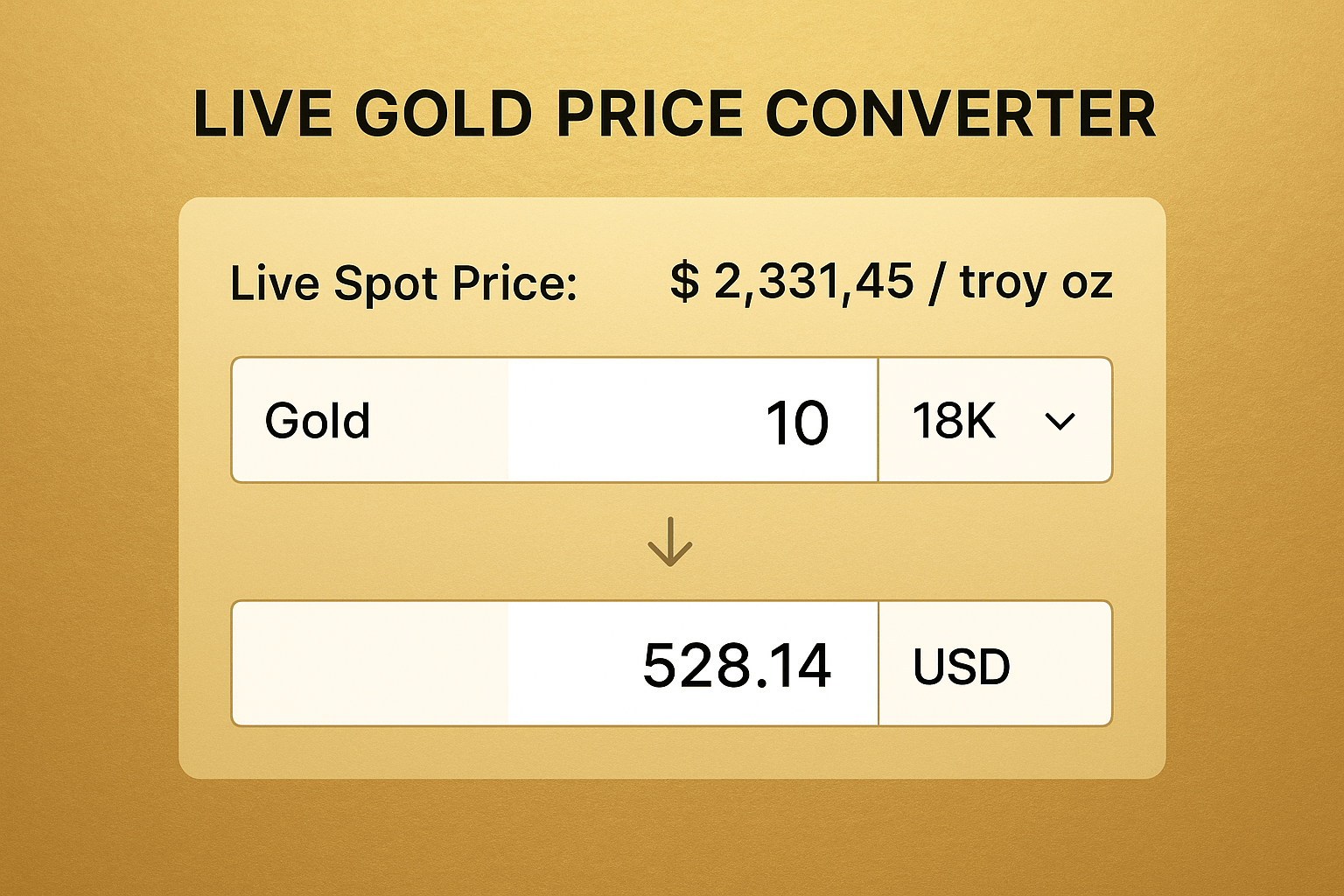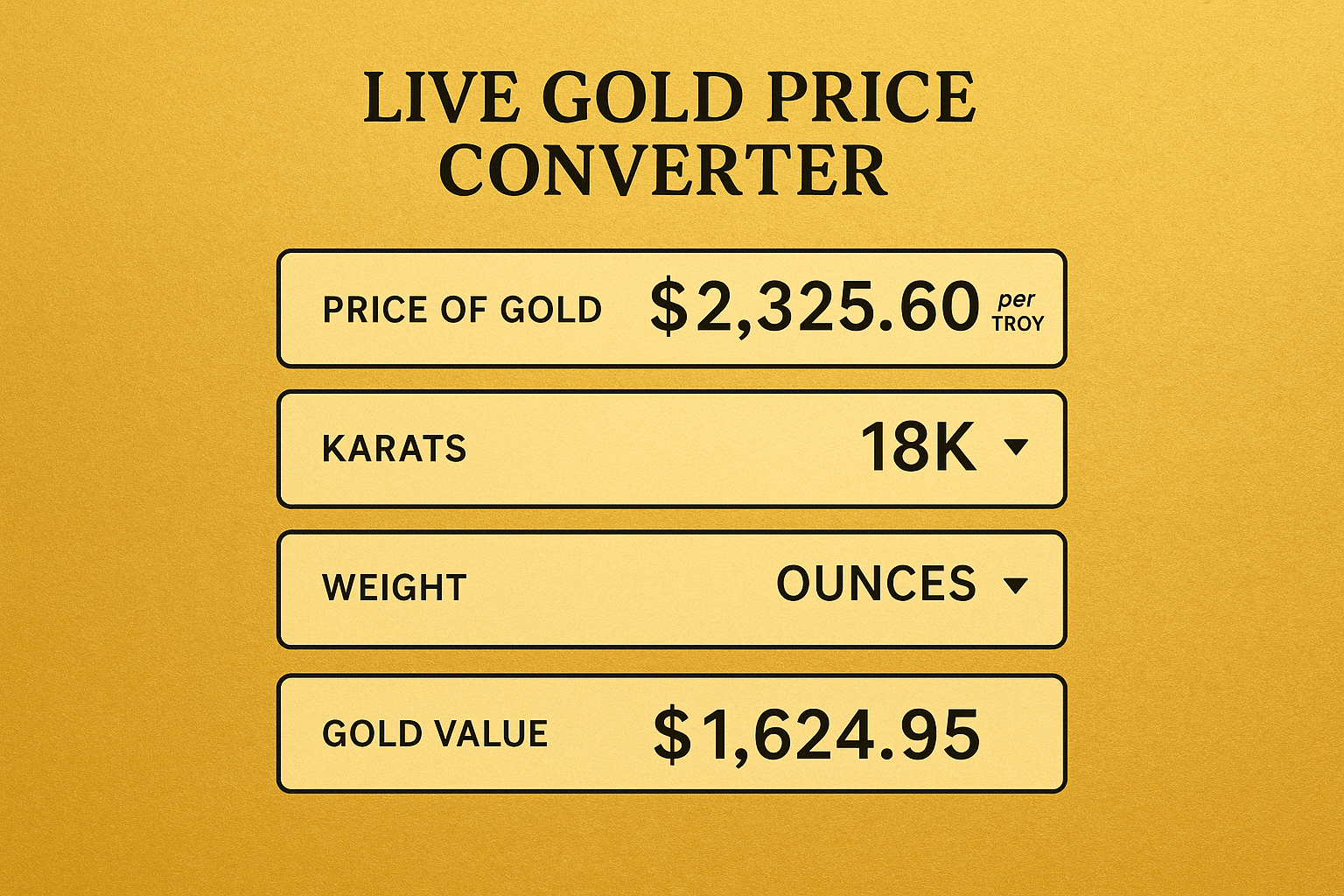Gold. For centuries, this lustrous metal (Live Gold Price Converter) has captivated humanity, symbolizing wealth, power, and beauty. But in today’s fast-paced financial world, understanding its value isn’t as simple as checking a single number. If you’ve ever tried to price a piece of jewelry, sell an heirloom, or simply track an investment, you’ve likely encountered a maze of terms: live spot price, karats (18K, 22K, 24K), and troy ounces. This is where a powerful tool comes into play: a live gold price converter.
This comprehensive guide will transform you from a confused observer into an informed enthusiast. We’ll break down exactly how a gold price calculator works, why karats matter so much, and how you can use this knowledge to make smarter decisions, whether you’re buying, selling, or just curious.
What is a Live Gold Price Converter?
At its core, a live gold price converter is a digital tool, often a website widget or a mobile app, that takes the constantly fluctuating global market price of gold—known as the “spot price”—and translates it into a value for the specific type of gold you own or are interested in.
Think of it like a currency exchange app. You wouldn’t expect one Euro to equal one US Dollar. Similarly, a pure 24-karat gold bar is not worth the same per gram as a 14-karat gold ring. The converter does the math for you, accounting for purity and weight, to give you a real-time, accurate valuation.
The Foundation: Understanding the Gold Spot Price
Before the converter can work its magic, it needs a baseline. This baseline is the live gold spot price.
-
What it is: The spot price is the current market price for one troy ounce of 99.99% pure (24-karat) gold, available for immediate delivery. It’s set by major global trading hubs like the London Bullion Market and COMEX in New York.
-
How it works: This price changes continuously throughout the trading day based on a complex interplay of factors, including:
-
Global Supply and Demand: Mining output, central bank buying/selling.
-
Economic Data: Inflation rates, interest rates, and employment figures.
-
Geopolitical Events: Wars, elections, and trade tensions can drive investors toward gold as a “safe-haven” asset.
-
US Dollar Strength: Since gold is priced in USD, a weaker dollar makes gold cheaper for other currencies, driving up demand and price.
-
Websites like Kitco or BullionVault provide real-time charts of this ever-changing spot price. This is the fundamental data point every gold converter uses.
https://example.com/gold-price-chart.jpg
Alt Text: A live updating chart showing the gold spot price, the key input for any gold price converter.
The Key to Purity: What Are Karats (K)?
This is the most critical concept for using a converter correctly. Karat (denoted with a ‘K’) is a measure of gold’s purity, not to be confused with ‘carat’ used for gemstone weight.
The karat system divides gold into 24 parts:
-
24K Gold: This is 100% (or 99.99%) pure gold. It’s a beautiful, rich yellow but is very soft and malleable, making it impractical for everyday jewelry. It’s primarily used for investment bars and coins.
-
22K Gold: This means 22 out of 24 parts are gold, equating to 91.7% purity (22/24 = 0.9167). The remaining 8.3% is alloys like silver or copper, which add strength and durability. 22K is very popular for high-purity jewelry, especially in South Asian and Middle Eastern markets.
-
18K Gold: This is 18 parts gold, or 75% pure (18/24 = 0.75). It offers an excellent balance between purity, beauty, and strength, making it the preferred choice for fine jewelry in Western markets. It has a slightly lighter gold color than 22K or 24K.
-
14K and 10K: These are even more alloyed, at 58.3% and 41.7% purity respectively. They are very durable and common in everyday jewelry, especially in the United States.
A live gold price converter must know the karat to calculate the actual gold content in your item.

How a Gold Price Calculator Actually Works: The Math Made Simple
Let’s walk through the calculation step-by-step. Don’t worry; the converter does this instantly, but understanding the process empowers you.
-
Get the Live Spot Price: The tool fetches the current price for one troy ounce of 24K gold. Let’s say it’s $2,000 per troy ounce.
-
Convert to Grams: The spot price is per troy ounce (approx. 31.1 grams), but jewelry is almost always weighed in grams.
-
Price per gram of 24K gold = Spot Price / 31.1
-
$2,000 / 31.1 ≈ $64.31 per gram
-
-
Adjust for Purity (The Karat Multiplier): This is the crucial step.
-
24K Multiplier: 24/24 = 1.0
-
22K Multiplier: 22/24 ≈ 0.9167
-
18K Multiplier: 18/24 = 0.75
-
-
Calculate the Value: Multiply the pure gold price per gram by the multiplier and then by the weight of your item.
Example: You have a 20-gram 18K gold bracelet.
-
Pure Gold Price per Gram: $64.31
-
18K Multiplier: 0.75
-
Price per gram for 18K gold: $64.31 * 0.75 = $48.23
-
Value of Bracelet: $48.23 * 20 grams = $964.60
This $964.60 represents the intrinsic melt value of the gold—what a refiner would pay for the raw material. It does not include the craftsmanship, brand name, gemstones, or retailer markup, which can significantly increase the price when buying new jewelry.
Using a Converter in the Real World: A Case Study
Scenario: Sarah inherits a 22-karat gold necklace from her grandmother. It weighs 30 grams. She wants to understand its base gold value before getting it appraised or considering selling it.
-
She goes to a reputable financial site like Kitco.com and sees the live spot price is $1,950 per troy ounce.
-
She finds a live gold price converter tool on the site (many have them).
-
She inputs:
-
Weight: 30 grams
-
Purity: 22 Karats (or she can select 91.7% purity)
-
-
The converter instantly calculates:
-
Price per gram for 24K: $1,950 / 31.1 = $62.70
-
22K Value per gram: $62.70 * 0.9167 ≈ $57.48
-
Total Gold Value: 30 * $57.48 = $1,724.40
-
This gives Sarah a powerful baseline. She now knows the necklace contains about $1,724 worth of gold. If a buyer offers her $1,000, she knows it’s a low offer. If an appraiser values it at $2,500, she understands that $726 of that value is from its antique and artistic merit.

Limitations and What a Converter Doesn’t Tell You
A live gold price converter is an essential starting point, but it’s not the final word.
-
It Provides Melt Value, Not Retail Price: The converter’s output is the wholesale value of the raw metal. When buying new jewelry, you will pay significantly more due to manufacturing costs, design, brand markup, and retailer profit.
-
It Doesn’t Account for Numismatic Value: Rare or historic coins can be worth many times their gold melt value due to their collectibility and condition.
-
Buyers Have Overheads: A reputable gold buyer or refiner will typically offer 5-20% less than the melt value to cover their refining costs, assay fees, and business profit.
Conclusion: Empower Yourself with Knowledge
Navigating the gold market no longer has to feel like deciphering an ancient code. A live gold price converter is the modern key to unlocking the true value of your gold possessions. By understanding the concepts of the live spot price and the karat system, you can move beyond guesswork.
Whether you’re checking the value of an family heirloom, making an informed investment, or simply ensuring you get a fair price at the market, this knowledge puts the power back in your hands. Use this guide, bookmark a reliable converter, and approach gold with the confidence of an expert.
Frequently Asked Questions (FAQs)
Q: Where can I find a reliable live gold price converter?
A: Reputable financial and bullion dealer websites like Kitco, JM Bullion, APMEX, and BullionVault all offer accurate and user-friendly converter tools that pull in live market data.
Q: Is 24K gold always the best investment?
A: For pure investment in the metal itself, yes, 24K bars and coins are best as they have the highest gold content and are highly liquid. However, for jewelry, higher karat gold is softer and can be less practical for daily wear.
Q: How often does the gold spot price change?
A: It changes continuously throughout the global trading day, which runs from Sunday evening to Friday afternoon (Eastern Time), with the most volatility during overlapping market hours in London and New York.
Q: My jewelry has a stamp that says “750” or “916.” What does that mean?
A: This is another way to denote purity. “750” means 750 parts per thousand gold, which is 75% pure—the same as 18K. “916” means 91.6% pure gold, which is the same as 22K.
Q: Does the converter work for white gold or rose gold?
A: Yes! White gold and rose gold are still made primarily from gold. They are mixed with different alloys (like nickel/palladium for white gold, copper for rose gold). A converter only cares about the gold content percentage (the karat), not the color. A 10-gram 18K white gold ring has the same gold value as a 10-gram 18K yellow gold ring.
Disclaimer: This article is for educational and informational purposes only and does not constitute financial, investment, or professional advice. The gold market is volatile, and prices can fluctuate significantly. You should conduct your own research and consult with a qualified financial advisor or professional appraiser before making any buying or selling decisions. The value calculated by any converter is an estimate of melt value and may not reflect the actual price you receive from a buyer. If you have any concerns about the content of this post, including issues related to ownership or copyright, please visit our DMCA page for guidance on the content removal process.
